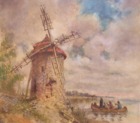| The circa 1823 house is the Grosse Pointe Historical Society's meeting place, now located at 376 Kercheval Road in Grosse Pointe Farms. Classes, special events, meetings, fundraisers and tours take place here for the community. Who built this house? Pierre Provencal, built the house for his wife Euphemie and daughter, Catherine. The family also took in 24 orphans over the years due to the cholera epidemic of the 1840s and 50s. Many children lost their parents and were orphaned during this time.
Was the house always located here? No. It used to be at the beach at the foot of what is now Provencal Road and was moved to its current location by horses pulling the house on top of log rollers about 1914. At that time the east side of the house was added. You can see the difference in the floor boards. The older part of the house has wider floor boards and the 1914 addition has the skinnier floor boards. When you step from the Parlor to the dining room you are jumping from 1823 to 1914!
What did they do for a living? About one hundred and seventy-five years ago, the mother cared for the children and ran the household (which was no small task before many of the modern conveniences we enjoy today). The children did their chores and worked the Ribbon Farm. The father worked the farm and was an "Indian Agent" and government blacksmith.
What is an Indian Agent? The Indian Agent played an ambiguous role in the lives of the Indian people. On the one hand, he was supposed to protect their interests. On the other hand, they were often obligated to act on behalf of the local settlers, whose interests were opposed to those of the Indians
What is a Ribbon Farm or Strip Farm? Early Grosse Pointers settled near the water and established their farm property with approximately 300 to 500 feet of lakefront and extending inland from 1 to 3 miles. This property usually began at the lake with a farmhouse and garden, and proceeded inland with a barn with animals, fruit orchards (apple, cherry and pear), wheat and corn fields and woods.
How did the Provencal’s get water? They used a well and a pump from somewhere on their farm property.
Where were the bathrooms? If they were lucky, they had an outhouse or privy. Inside the house they would have a wash basin and a chamber pot.
How did they cook? In 1823, the parlor and the original kitchen shared the fireplace now seen in the parlor. Not only would this provide the heat to the house it was also the stove and provided light.
How did they find their food? Fishing, hunting and farming.
Where did they sleep? The Provencal's second floor did not look like it does now. It was simply a "sleeping loft" where the family bunked for the night and in the summer often people slept on their porches to stay cool.
Did the kids go to school? Pierre Provencal and his wife had a school in the home for their children.
What did the children do for fun? Played baseball, went swimming and fishing, flew kites, played marbles, checkers, ice skating on the lake, made corn-husk dolls, rode horses.
Was there shopping? No. Maybe you could find a fruit and vegetable stand and a fish market on your way to Detroit. You could take a half a long horse ride to Detroit to find goods and services. Everything a farm grew they would try to can for food for the winter.
Did they go to church? Since the closest church was a several hour horse and buggy ride into Detroit, the Provencal's offered their parlor for local religious services. Father Gabriel Richard, a religious and cultural leader of Detroit, was one of the circuit-riding priests who came to the Provencal parlor to celebrate mass.
How was the telephone used? Turn the crank, which would send a signal to the telephone office on Fisher Road. When the operator answered you would give them the name of the person you are trying to reach. The operator would then manually plug into a telephone switchboard connecting you to their phone.
|



